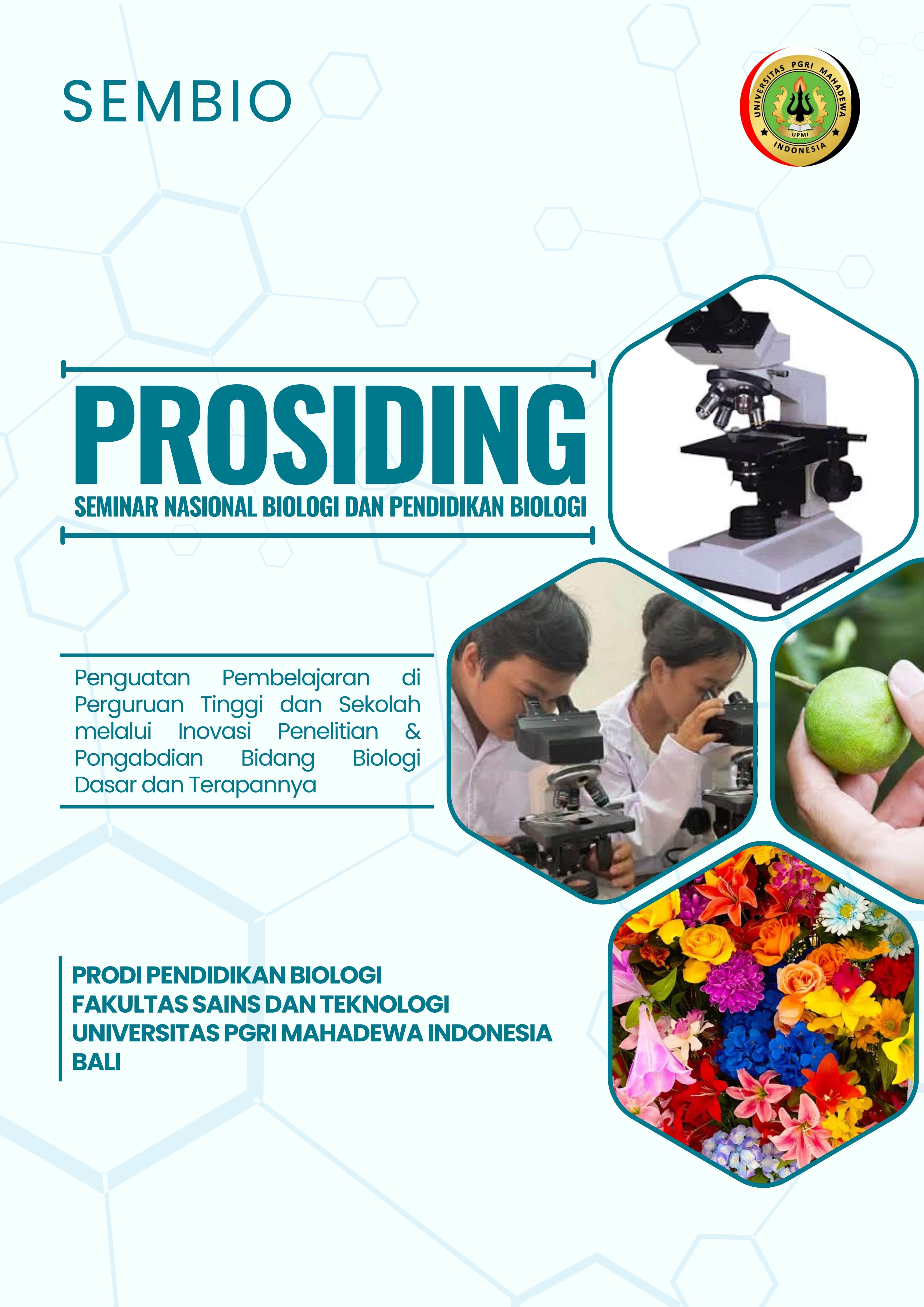KONSERVASI SUMBER DAYA ALAM HAYATI BERBASIS ETNOBIOPEDAGOGI (KAJIAN TEORITIS)
DOI:
https://doi.org/10.59672/sembio.v3.4572Keywords:
Ethnobiopedagogy, Relevance, Strategy, ChallengesAbstract
The research objectives are to (1) define the basic concepts of ethnobiopedagogy, (2) determine the relevance of local wisdom in preserving biodiversity, (3) determine strategies and forms of integration of ethnobiopedagogy in education and conservation. (4) to find out the challenges and opportunities in its implementation. To achieve this goal, a theoretical literature review was carried out using sources relevant to material on the conservation of biological natural resources based on ethnobiopedagogy (ethnobiology, pedagogy). Conclusions from the theoretical study include: (a) Ethnobiopedagogy is a strategy, an innovative approach in the conservation of biological resources that focuses on the field of education by integrating ethnic values, pedagogy and biology. (b) Local wisdom in preserving biodiversity has very strong and deep relevance. (c) Integration of Ethnobiopedagogy in Education and Conservation, as an intersection of at least three components, namely formal and non-formal education; forms of local wisdom traditions that still exist; and use of Information and Communication Technology. (d) Challenges in implementing Ethnobiopedagogy, namely low human resources, lack of curriculum integration, and the threat of modernization to local wisdom practices.
Downloads
References
Adal, C. (2025). Tradisi Guti Nale di Minggar Lembata, Berburu Cacing Laut pada Bulan Februari dan Maret. Tribunflores.com, tersedia pada link: , https://flores.tribunnews.com/2025/02/20/tradisi-guti-nale-di-minggar-lembata-berburu-cacing-laut-pada-bulan-februari-dan-maret
Adiningsih, Y. (2021) Tradisi Sasi, Cara Unik Papua Menjaga Laut Panjang Umur.
CNN Indonesia https://www.cnnindonesia.com/gaya-hidup/20210611225656-269-653397/tradisi-sasi-cara-unik-papua-menjaga-laut-panjang-umur.
BPODT. (2024). Tujuh Keajaiban di Aek Sipitu Dai. Tersedia pada link: https://www.bpodt.id/tujuh-keajaiban-di-aek-sipitu-dai-2/
Dislhk. (2019). Kerusakan Lingkungan Hidup di Indonesia dan Penyebabnya. Dinas Kebersihan dan Lingkungan Hidup Kabupaten Badung. Tersedia pada link: https://dislhk.badungkab.go.id/artikel/18289-kerusakan-lingkungan-hidup-di-indonesia-dan-penyebabnya
Falensya Nampasnea, dan Billy Seipalla (2023). KONSERVASI SUMBER DAYA ALAM HAYATI BERBASIS KEARIFAN LOKAL PADA BEBERAPA NEGERI DI KECAMATAN LEIHITU BARAT, KABUPATEN MALUKU TENGAH. Jurnal Hutan Tropis Volume 11 No. 2 Juni 2023. Halaman 189-197. Link: https://ppjp.ulm.ac.id/journal/index.php/jht/article/view/16768/9244
Ida Ayu Komang Candraningsih, Ida Bagus Gde Pujaastawa, I Gusti Putu Sudiarna. (2018). Konservasi Hutan Berbasis Kearifan Lokal di Desa Tigawasa, Kecamatan Banjar, Kabupaten Buleleng. Jurnal Humanis, Fakultas Ilmu Budaya Unud Vol 22.2 Mei 2018: 311-319.
Johan Iskandar (2016). Etnobiologi dan Keragaman Budaya di Indonesia. UMBARA: Indonesian Journal of Anthropology. Volume 1 (1) Juli 2016. Hal. 27-42.
Kementerian Pariwisata dan Kementerian Ekonomi Kreatif, Badan Ekonomi Kreatif dan Pariwisata Republik Indonesia (2025). Mengenal Tradisi Menjaga Bumi dari Berbagai Daerah di Indonesia. https://www.kemenparekraf.go.id/ragam-pariwisata/mengenal-tradisi-menjaga-bumi-dari-berbagai-daerah-di-indonesia
Taghfirin. 2014. “Sasi, Tradisi Adat Menjaga Sumberdaya.” (Diposting 22 Juli 2014) www.taghfirin.wordpress.com.
Tike Aprillia, ST, Fella Faradiva, dan Mutia Arifah Rachim. (2020). URBAN HEAT ISLAND (UHI). Tersedia pada tautan: https://www.handalselaras.com/urban-heat-island-uhi/
Tina1, Qolby, Alhaq (2019) KAJIAN KEPEDULIAN MASYARAKAT BERBASIS KEARIFAN LOKAL DALAM UPAYA PELESTARIAN LINGKUNGAN DI DESA PENGLIPURAN BALI Tersedia pada link: https://journal.unj.ac.id/unj/index.php/plpb/article/view/8024/8416
Sistem Informasi Kearsipan Kabupaten Karangasem.(2019). Kumpulan Awig Subak, Kabupaten Karangasem-Bali. link: http://sikn.karangasemkab.go.id/kumpulan-awig-subak-kabupaten-karangasem-bali
Suryansah, E., (2025). Bau Nyale Dimulai, Warga Lombok Tengah Tumpah Ruah Berburu Cacing di Pantai. Tersedia pada link: https://www.detik.com/bali/nusra/d-7780580/bau-nyale-dimulai-warga-lombok-tengah-tumpah-ruah-berburu-cacing-di-pantai.
Reza Saputra (dikunjungi 2024). Konservasi Alam Berbasis Kearifan Lokal yang dilakukan oleh Suku Kokoda di Kepulauan Ugar, Kabupaten Fakfak, Papua Barat. BBKSDA PAPUA BARAT KEMENTERIAN LINGKUNGAN HIDUP DAN KEHUTANAN.tersedia pada link: https://bbksda-papuabarat.com/konservasi-alam-berbasis-kearifan-lokal-yang-dilakukan-oleh-suku-kokoda-di-kepulauan-ugar-kabupaten-fakfak-papua-barat/
Rismei. (2024). Tradisi Resik-Resik Resan : Juga Menjaga Kelestarian Alam. Kalurahan TepusKapanewon Tepus Kabupaten Gunungkidul. https://desatepus.gunungkidulkab.go.id/first/artikel/4032-Tradisi-Resik-Resik-Resan---Juga-Menjaga-Kelestarian-Alam-
Ladislav Kováč (2013). Biopedagogy. EMBO Reports 14(4). March 2013 DOI: 10.1038/embor.2013.18 · Source: PubMed https://www.researchgate.net/publication/235786493_Biopedagogy
Wihardandi, Aji. 2013. “Kesadaran Masyarakat Adat Lebih Berikan Dampak Positif Bagi Pelestarian Alam Dibanding Ekspansi Modal”. (Diposting 19 Juli 2013).
Yudha Ahmada, Arif Fakhruddin (2024) Sumber Daya Kearifan Lokal untuk Konservasi Lingkungan Hidup. Jurnal Ekologi, Masyarakat dan Sains. Volume 5, Nomor 1, 2024. Hal. 100-108. Link: https://journals.ecotas.org/index.php/ems/article/view/149
Shiffa Febyarandika S., Muhammad Abdul Chafid. (2016). TRADISI SASI DI RAJA AMPAT PAPUA. Sabda, Volume 11, Tahun 2016. 55-66. Link: https://ejournal.undip.ac.id/index.php/sabda/article/viewFile/13240/10025
Downloads
Published
How to Cite
Issue
Section
License
Copyright (c) 2025 SEMBIO: Prosiding Seminar Nasional Biologi dan Pendidikan Biologi

This work is licensed under a Creative Commons Attribution-ShareAlike 4.0 International License.
Authors who publish with the Jurnal Sewagti agree to the following terms:
1. Authors retain copyright and grant the journal the right of first publication with the work simultaneously licensed under a Creative Commons Attribution License (CC BY-SA 4.0) that allows others to share the work with an acknowledgment of the work's authorship and initial publication in this journal.
2. Authors are able to enter into separate, additional contractual arrangements for the non-exclusive distribution of the journal's published version of the work (e.g., post it to an institutional repository or publish it in a book), with an acknowledgment of its initial publication in this journal.
3. Authors are permitted and encouraged to post their work online (e.g., in institutional repositories or on their website) prior to and during the submission process, as it can lead to productive exchanges, as well as earlier and greater citation of published work. (See The Effect of Open Access) .









